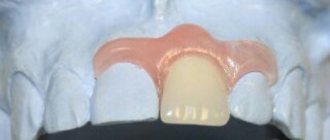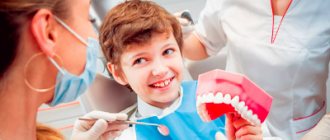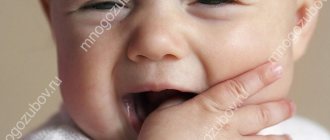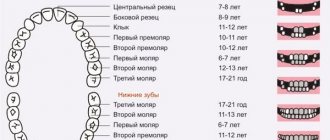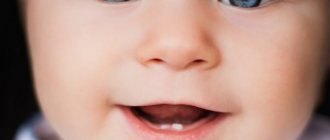Signs of changing baby teeth
Before the molars appear, a very interesting physiological process begins - the independent resorption of milk. At this time, the milk units become mobile and fall out. The rudiments of permanent teeth appear in the area of the roots of primary dental units. In this place, where the root is adjacent to the permanent tooth germ, the resorption process begins, which leads to the loss of the baby tooth.
The final release of the oral cavity from baby teeth occurs around the age of fourteen. This process occurs individually for everyone, so for some it ends earlier, for others later.
The process of loss of the milk and the appearance of the radical occurs simultaneously. Most often, the appearance of teeth and their loss occurs according to the following scheme:
- first the incisors;
- first molars;
- fangs.
The first molars appear a little later, despite the fact that they begin to grow long before the milk teeth fall out. Second molars appear only when the jaw grows and there is room for them. Third molars, called wisdom teeth, can appear at any age or may not grow at all.
Why can a lot of time pass between the loss of baby teeth and the eruption of permanent teeth?
Most often, the front teeth grow quickly. And canines and baby molars (premolars) can be delayed. After a temporary tooth falls out, it may even take 4-6 months until a permanent tooth erupts in that place. Just expect it and take good oral care. But if this period begins to exceed six months, so as not to worry, it is better to visit a doctor. After examining the child, he will be able to decide whether the permanent tooth needs to be stimulated to grow.
Deadlines
At the age of five, teeth can become mobile. Then the process of loss and growth of new ones begins:
- six to seven years – lower and then upper central incisors;
- seven to eight years - the lateral incisors change;
- eight to ten years – first molars;
- nine to eleven years – fangs;
- eleven to thirteen are second molars.
The correct formation of the jaw depends on many factors: how the pregnancy proceeded, how long the child was breastfed, what infectious diseases were suffered, etc.
Molars in children
Of course, molars in children deserve a separate discussion. Firstly, because parents often confuse which teeth are milk and which are permanent, and secondly, because their eruption causes extremely unpleasant and even painful sensations and is often accompanied by an increase in temperature.
When do molars grow?
Many parents believe that molars are permanent teeth, that is, those that replace milk teeth. But actually it is not. So what kind of teeth does the child have? In fact, molars are divided into permanent and primary teeth. In this case, the order of eruption of molars in children is as follows. At six months, babies begin to notice their first molars. There are four of them, and they are located on the lower and upper parts of the jaw apparatus. At one and a half years, central molars appear, at two and a half, lateral molars. From 5 to 10 years, baby teeth are replaced by permanent teeth. Until about 25 years of age, the most complex tooth, the “wisdom” tooth, emerges.
What symptoms accompany tooth growth?
Not all parents know how their children’s molars grow, which is why they begin to worry a lot when they notice some unpleasant symptoms. Let's figure out what phenomena accompany tooth growth.
Fever. During the period of teeth growth, children can maintain a temperature of 37–37.5 °C. In some cases it rises to 38 °C. Why is this happening? The fact is that when the gums become swollen, the blood flow increases, and to compensate for the swelling, the body produces biologically active substances, which affects the state of the immune system. As a result, the temperature rises.
General malaise. Very often, when teething, children seem lethargic and tired. This is due to the fact that it is a lot of stress for the body. As a result, the child may have trouble sleeping; babies often become irritable, spit out the pacifier, start sucking their thumbs, and are constantly capricious.
Increased salivation. This is especially observed in young children (aged 5–7 months). At this time, they do not yet independently regulate the amount of saliva in their mouth. A large amount of saliva indicates irritation of the sensitive nerves of the gums, which is completely normal when teeth appear. Over time, with the development of the reflex, the amount of saliva decreases.
Digestive disorder. Teething is often accompanied by vomiting, diarrhea and regurgitation. The reason for this is an increase in the amount of liquid the baby drinks during the day.
How can I help you
In order to speed up the teething process, small children can be given special toys. They are usually made in the form of rings. Instead of these items, you can use a regular crust of bread or peeled fresh carrots. Also during this period, it is recommended that the child be given cool drinks, preferably just water. You can distract babies and older children with the help of games, conversations, and fun music. Do not forget that during this period the child needs double affection and special care from the parents. For severe pain, doctors prescribe age-appropriate analgesics. You can apply a clean, soft cloth soaked in cold water to your gums. This is especially useful before bedtime, as this approach will help relieve pain and allow the child to fall asleep.
Do baby teeth need to be treated?
Caries is quite common in children at a very young age. To prevent caries, parents should pay special attention to their baby’s oral hygiene.
You need to treat caries in baby teeth! If caries is not treated, it can cause serious complications:
- early (unnatural) removal can lead to incorrect formation of a permanent tooth or to disruption of bite formation;
- violation of chewing function, which leads to the development of gastrointestinal pathologies;
- the development of pulpitis or periodontitis, which can provoke purulent inflammatory processes.
Replacing baby teeth with permanent ones: what should parents pay attention to?
The process of replacing children's milk teeth with permanent ones requires increased attention from parents. It is necessary to monitor the child’s adequate nutrition and oral hygiene, and if there are deviations from the norm, immediately contact a dentist
Every person in childhood goes through a period when temporary teeth are replaced with permanent ones. In most cases, this process does not cause any problems. However, parents should still know what exactly to pay attention to when a child’s baby teeth fall out and permanent teeth appear.
Causes of loss of baby teeth
There are very specific reasons for the process of changing a set of teeth after a certain age. The fact is that children erupt their first teeth before they reach the age of one, when more dense foods than milk appear in the diet. However, the child’s jaws at this time are still quite small, and the first teeth that grow have a corresponding size. And milk teeth themselves, which have weak enamel, are not very strong.
Gradually, as the baby grows up, the chewing load on the teeth increases due to the intake of increasingly solid foods. This requires the formation of an appropriate masticatory apparatus. By this time, the growing child's jaws are just large enough to accommodate the entire set of permanent teeth. Therefore, the process of loss of milk teeth and the appearance of stronger molars, necessary for a full future life, begins.
At what age do baby teeth change?
Parents often mistakenly believe that the process of changing primary teeth begins with the loss of the first milk tooth. As a rule, this occurs at the age of 6-7 years. However, doctors take as a starting point the appearance of the first permanent teeth - third molars, which are absent in the “deciduous bite”. This process is observed at the age of 5-6 years. It is at this time that the process of resorption of the roots of temporary teeth begins, which lasts approximately 2 years. Gradually, baby teeth begin to loosen, and by the time the molars appear, they fall out.
The age at which teeth change varies from person to person, and the time difference is sometimes up to 2 years. Experts note that this factor may also depend on the region of residence: in warmer climates, permanent teeth appear earlier. It is also known that girls replace their baby teeth with molars a little faster than boys.
What to pay attention to during the period of teeth change?
Proper nutrition
The process of final formation of enamel during the eruption of permanent teeth takes several years. And during this period, proper nutrition becomes extremely important, thanks to which the child must receive all the substances necessary for the body.
Parents should pay attention to the following points:
- the child’s daily diet should include foods with a good calcium content - milk, cottage cheese, cheeses;
- the diet should be supplemented with fresh fruits and vegetables to obtain the required amount of vitamins and microelements;
- at least 1-2 times a week, to obtain a sufficient amount of phosphorus, you need to include fish dishes in the menu;
- Until the final formation of the enamel of the molars, it is advisable to give up sweets, chocolate and sweet pastries. Sweet soda is also extremely dangerous for young enamel;
- The child should eat some food, such as fruits and vegetables, in solid form. The load on the teeth will stimulate the resorption of the roots of baby teeth, helping the eruption of molars;
- in some cases, for example, if a child does not eat dairy products well, the baby’s diet should be supplemented with a multivitamin complex with calcium.
It is better to exclude the hardest or most chewy foods, such as nuts or toffees, from the diet completely during the period of teeth change. Their use can lead to injury or early loss of primary teeth, which will interfere with the proper growth of permanent teeth.
Oral hygiene
As already mentioned, permanent teeth appear with weak, not yet fully formed enamel. Therefore, oral care to prevent tooth decay is very important.
Proper oral hygiene in a child involves morning and evening brushing of teeth using children's toothpastes that have an optimal content of calcium and fluoride. To avoid injury to the gums, it is better to choose a toothbrush with soft bristles. It can also be helpful to teach your child how to use children's dental rinses. Ideally, it is advisable to rinse your mouth every time after eating - this will optimally prevent the formation of plaque.
Visiting the dentist
Special attention should be paid to the medical prevention of dental diseases during the period of teeth change. For preventive purposes, dentistry for children should be visited at least 2 times a year. And if there is a need to treat a child’s teeth, then you need to go to the doctor as quickly as possible. After all, caries in children with teeth with still weak enamel can develop very quickly.
Early and late change of primary teeth
Sometimes situations arise when the replacement of temporary teeth with permanent ones in children occurs in violation of the deadlines. Let's consider what parents should do in such cases.
Early tooth loss
The loss of baby teeth can be called early if it occurs before the age of 6 years. As a rule, such situations arise due to injury, dental disease, or intentional loosening of a tooth. The main problem here is that when a baby tooth disappears, free space appears in the dentition. And if the permanent tooth does not begin to grow after the loss of the temporary one, then gradually the neighboring milk teeth will begin to move, filling the resulting volume. In the future, this will lead to the fact that the molars will not have enough space for normal eruption, and the dentition will be uneven.
With the early loss of a temporary tooth, pediatric orthodontics comes to the rescue. Currently, modern techniques are available to doctors to prevent the displacement of adjacent teeth. Therefore, in case of early loss of a baby tooth, it is advisable to immediately go for a consultation with an orthodontist. After all, correcting cosmetic defects and correcting the bite will bring much more trouble in the future.
Late replacement of primary teeth
There are two possible scenarios here. The first is when molars do not appear in a timely manner, even if the milk teeth have already fallen out. There may be several reasons for this anomaly, from a physiological delay in the appearance of new teeth to incorrect positioning of the tooth inside the jaw apparatus. The second scenario is when the molars began to erupt before the baby teeth fell out. The result can also be the formation of bite defects.
If a child shows signs of a delayed change of teeth, it is necessary to contact a dentist to identify the causes of the deviations. As a rule, the doctor will be able to tell about the causes of the anomaly after an X-ray examination, after which appropriate treatment will be prescribed.
How and when do baby teeth emerge?
As a rule, before the next tooth erupts, children experience general malaise, sleep poorly and are capricious. The child's general immunity decreases and the temperature may even rise slightly.
The first teeth (central incisors) appear between 6 and 9 months: first in the lower jaw, then in the upper jaw. By the age of 13 months, the baby should acquire upper and lower lateral incisors, and by one and a half years, upper and lower molars.
Then the child’s canines erupt, and the last, by the beginning of the third year of life, are the second molars. The sequence of baby teeth eruption is presented in more detail in the diagram.
